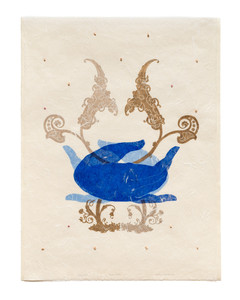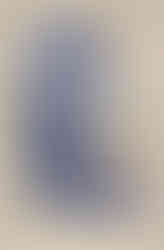IMPRINT Magazine, Vol 60
- Niloufar Lovegrove
- Mar 22
- 5 min read
Updated: Jun 12

Marguerite Brown
Curator, Whitehorse Artspace
IMPRINT magazine, Autumn 2025, Vol.60 No.0
Nourishing Hands
Niloufar Lovegrove's latest series of works engages with a potent symbol of courage and freedom for women, especially those living in Iran, writes Marguerite Brown.

The cypress tree is evergreen and grows tall and proud throughout Iran. It is a cherished symbol in Persian art that represents immortality, beauty and in literature often serves as a metaphor for the beloved. In Cypress Growing Season, an exhibition by Iranian/Australian artist Niloufar Lovegrove, this potent symbol speaks to the enduring courage of the women of Iran and throughout the world who continue to pursue their freedom, and like the cypress tree, stand tall and resilient.
In 2022, the slogan Women, Life, Freedom became globally recognized following the death of Mahsa Amini in police custody in Iran, after she was arrested for allegedly violating rules that require women to wear the headscarf. The outrage that followed this tragedy birthed a movement, and Lovegrove’s poetic response to it has underpinned much of her recent practice.
In her large multi-panel linocuts, such as Glorious Peace of 2023 which was awarded the Burnie Print Prize that year, Lovegrove depicts a goddess with streaming hair that flows through the landscape like a river, feeding the earth below. In defiance of the brutality
enacted upon women for the exposure of hair, in this work and the related 54 panel iteration Equable Goddess (2022), hair becomes transformed into a symbol of abundance, a source of life for an imagined utopian landscape.
As stated by the artist, “Women have always fought, and continue to fight, for the fundamental rights to their own bodies, thoughts, and lives—from the freedom to choose how they dress and whom they love, to voting rights, fair wages, and giving birth in a hospital without fear of bombardment. This exhibition does not aim to diminish the unique courage of Iranian protesters by connecting their motto to broader issues; rather, it seeks to honour the universal essence of women’s resistance across time and place.”1
Resistance can take many forms, both visible and invisible. It exists in physical protest, and just as powerfully in the mental and emotional fortitude to maintain belief that freedom is possible and that individuals have the power to imagine the world anew. For many who live
under systemic oppression, resistance is also embedded in the creative act.
Another Birth, 2025, hand printed lino on Okawara. Image: Courtesy of the artist
Forugh Farrokhzad (1934 – 1967) was a groundbreaking Iranian modernist poet who life and creative practice embodied the pursuit of freedom. Her powerful work expressed a rich inner life at a time in Iran when for women even speaking about emotions was frowned upon. In her poem Another Birth she writes:
I will plant my hands in the garden
I will grow I know I know I know
and swallows will lay eggs
in the hollow of my ink-stained hands.2
It was this verse that inspired Lovegrove’s series of prints that centre on the depiction of hands. Here the floating forms of stylised hands are printed, sometimes on two sheets which are overlaid and stitched together with motifs reminiscent of birds and trees from woven Persian kilims.
From top left: Blooming Hands, Bounty Bloom, Gathering Clouds, Fertile Offering, Echoed Shelter, 2025, hand printed lino on Tengucho & Okawara paper, hand sewn together. Image: Louis Lim. Courtesy of the artists and Onespace.
In this series hands carry the clouds that water the earth. Blooms sprout from fingertips as they hold mountains and form sheltered spaces, creating and nurturing a new landscape. Representing the continual commitment of women in Iran and around the globe to shape a new reality, Lovegrove contrasts the bold simplicity of the hands with the intricate shapes that derive from the natural world and are uniquely Persian in style of ornamentation. The layering of the two sheets of paper creates the effect of a ghosted image behind the clearer impression on top. In this way as the artist seeks to pay homage to the souls departed, along with those who remain and continue this essential work of world building.
Spinning a Dream and Oud Player, 2025, hand printed lino on Tengucho & Okawara paper. Image: Courtesy of the artist
In the large-scale linocut Spinning a Dream a figure in totality is depicted. But instead of hair, a cluster of clouds swirls around her head and is directed by her fingers into the vessel below. Similarly in Oud Player a kneeling woman plays the Middle-Eastern lute-type instrument, her hair stretching out to connect with the strings that run down the neck of the oud. In both images the artist frames a visceral connection between the mind, body and intention as fundamental to the expression of women’s agency. As she states, “the women are mending, planting, creating the landscape… it's about looking after yourself, your ideas, and your world.”3

One quality that seems fundamental to Lovegrove’s art is that of balance. The ability to restore balance to the world through our thoughts and deeds is a message present throughout this body of work, while aesthetically the composition of her narrative images and the elegant series of hands achieve a visually satisfying harmony. It is an attribute central to her printmaking practice, as she states:
“It may sound like an exaggeration, but printmaking seems to hold the very essence of life! There’s a beautiful blend of traditional and contemporary techniques involved. Each stage of the process demands meticulous attention and intuition, from thoughtful design choices to precise carving and sharpening of chisels, to protecting the plate from any imperfections, whether it’s dust or stray eyelashes, until the final image is revealed. It is the process that requires you to be mindful and aware. So, when I am satisfied with the final print, it feels as though life itself is balanced and in order.”4
With a precise visual language where rich ornamentation and simple form is married with exquisite poise, Lovegrove honours those whose vision outlasts their suffering. In doing so she reclaims the beauty and joy possible in a future reimagined.
Marguerite Brown
Curator, Whitehorse Artspace
1. Niloufar Lovegrove artist statement, 2024
2. Forugh Farrokhzad, Another Birth https://www.forughfarrokhzad.org/selectedworks/selectedworks1.php accessed 30 Jan 2025.
3. Niloufar Lovegrove in conversation with the author, 31 Jan, 2025.
4. Niloufar Lovegrove ‘Too little, too much’ IMPRINT blog Too Little, Too Much – Print
Council of Australia accessed 1 Feb 2025





















